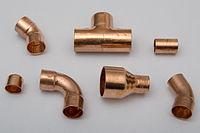
Photo from wikipedia
Abstract Fibre-reinforced polymer (FRP) tube-concrete-encased steel (FTCES) column, which consists of an FRP tube, encased steel section and concrete filled between them, attracts the attention of more and more researchers… Click to show full abstract
Abstract Fibre-reinforced polymer (FRP) tube-concrete-encased steel (FTCES) column, which consists of an FRP tube, encased steel section and concrete filled between them, attracts the attention of more and more researchers since it has excellent corrosion resistance, superior strength, stiffness and ductility. However, experimental studies on FTCES columns are relatively limited compared with other composite columns, such as concrete-filled-steel-tube columns. Moreover, existing analytical models predicting the load-strain relationships on the FTCES columns were all design-oriented models. A scientifically more rigorous analysis-oriented model is required to explain the complicated physical conditions at the interface among concrete, encased steel and FRP tube, which should consist of a concrete dilation model based on equilibrium and compatibility conditions. Herein, to understand more thoroughly and simulate the uni-axial performance of FTCES columns, an experimental study, consisting of 41 specimens has been conducted. The main parameters are FRP tube thickness, encased steel shape and ratio. Moreover, an analysis-based path dependent load-strain model, previously developed by the authors for the FRP tube-confined concrete columns, has been modified for the FTCES columns. The validity of the proposed model is confirmed by the good agreement obtained between the measured axial load-strain curves of FTCES columns and the theoretically proposed values.
Journal Title: Composite Structures
Year Published: 2020
Link to full text (if available)
Share on Social Media: Sign Up to like & get
recommendations!